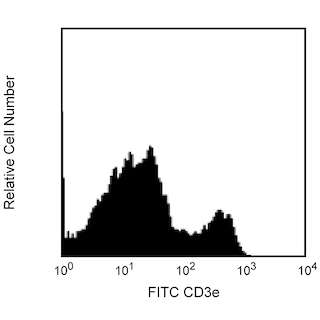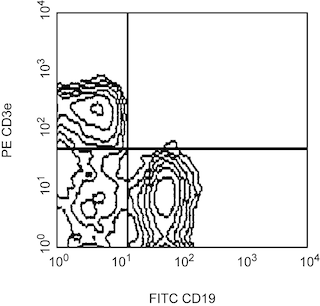Old Browser
Looks like you're visiting us from {countryName}.
Would you like to stay on the current country site or be switched to your country?


.png)

Two-color analysis of the expression of CD73 on splenic T and B lymphocytes. C57BL/6 splenocytes were stained with either PE-conjugated isotype control mAb R35-95 (Cat. No. 553930, left panel) or PE-conjugated mAb TY/23 (middle and right panels). T or B lymphocytes were identified by staining with FITC-conjugated anti-mouse CD3e mAb 145-2C11 (Cat. No. 553061/553062, left and middle panels) or FITC-conjugated anti-mouse CD19 mAb 1D3 (Cat. No. 557398/553785, right panel), respectively. Flow cytometry was performed on a BD FACSCalibur™ flow cytometry system.
.png)

BD Pharmingen™ PE Rat Anti-Mouse CD73
.png)
Regulatory Status Legend
Any use of products other than the permitted use without the express written authorization of Becton, Dickinson and Company is strictly prohibited.
Preparation And Storage
Product Notices
- Since applications vary, each investigator should titrate the reagent to obtain optimal results.
- Please refer to www.bdbiosciences.com/us/s/resources for technical protocols.
- For fluorochrome spectra and suitable instrument settings, please refer to our Multicolor Flow Cytometry web page at www.bdbiosciences.com/colors.
- Caution: Sodium azide yields highly toxic hydrazoic acid under acidic conditions. Dilute azide compounds in running water before discarding to avoid accumulation of potentially explosive deposits in plumbing.
Companion Products
.png?imwidth=320)


The TY/23 monoclonal antibody specifically binds to CD73 or Ecto-5'-nucleotidase (5'-NT), a 69 kDa GPI-anchored cell-surface protein with enzymatic and signal transduction activities. 5'-NT catalyzes the dephosphorylation of extracellular nucleoside 5' monophosphates into a form which can enter cells to meet their metabolic needs. It also regulates the concentration of extracellular adenosine, which initiates a variety of physiological responses through the adenosine receptors in many tissues. CD73 expression appears to be developmentally regulated on leukocytes. In the bone marrow, it is found on most CD11b+ myeloid cells and very few CD19+ cells of the B-lymphocyte lineage. It is not found on CD11b+ cells in the periphery nor on marrow-derived GMCSF-stimulated dendritic cells. Some peripheral B lymphocytes express CD73, with higher levels on isotype-switched B cells. The few thymocytes which have detectable surface CD73 are of the CD4-CD8- (double negative) and the single-positive populations. In the peripheral lymphoid organs, significant subpopulations of the CD4+ and CD8+ T lymphocytes express CD73, with variation in the percentages of CD73-bearing T cells observed among inbred mouse strains. In the thymus and peripheral lymphoid organs, CD73 is found on endothelia and stromal cells. CD73 has also been detected on bone marrow and thymic epithelial cell lines, kidney glomeruli and proximal-tubule epithelial cells, and liver endothelial cells and hepatocytes. The TY/23 mAb inhibits the enzymatic activity of CD73. Although soluble TY/23 mAb by itself does not affect T lymphocyte proliferation, it is an effective co-stimulator with PMA, but not with Concanavalin-A or plate-bound anti-CD3ε mAb 145-2C11.

Development References (2)
-
Resta R, Yamashita Y, Thompson LF. Ecto-enzyme and signaling functions of lymphocyte CD73. Immunol Rev. 1998; 161:95-109. (Biology). View Reference
-
Yamashita Y, Hooker SW, Jiang H, et al. CD73 expression and fyn-dependent signaling on murine lymphocytes. Eur J Immunol. 1998; 28(10):2981-2990. (Immunogen). View Reference
Please refer to Support Documents for Quality Certificates
Global - Refer to manufacturer's instructions for use and related User Manuals and Technical data sheets before using this products as described
Comparisons, where applicable, are made against older BD Technology, manual methods or are general performance claims. Comparisons are not made against non-BD technologies, unless otherwise noted.
For Research Use Only. Not for use in diagnostic or therapeutic procedures.
Refer to manufacturer's instructions for use and related User Manuals and Technical Data Sheets before using this product as described.
Comparisons, where applicable, are made against older BD technology, manual methods or are general performance claims. Comparisons are not made against non-BD technologies, unless otherwise noted.
Report a Site Issue
This form is intended to help us improve our website experience. For other support, please visit our Contact Us page.